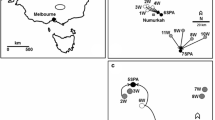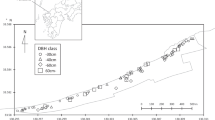Abstract
Genetic variation in a plant species is a key to its ability to survive and evolve in the face of changing environmental pressures. Due to insect and disease impacts, changes in fire regimes, and a changing climate, many populations of high elevation white pine species continue to experience high mortality levels and potentially worrisome decreases in genetic variation. In recent years, some trees rated highly for resistance to the non-native white pine blister rust have been killed by fire or mountain pine beetle. Ex situ genetic conservation offers the possibility to conserve the genetic variation within a species before much of it is lost. For many conifer species, freezer storage of seed offers a relatively inexpensive, long-term method of storing germplasm for future use. However, there is uncertainty concerning how long seed of some conifers can be stored and retain viability. We report here on results of germination testing of the oldest known seedlots of whitebark pine (Pinus albicaulis Engelm.) and foxtail pine (P. balfouriana Grev. & Balf.), some of which had been in storage for several decades. The 52 whitebark pine seedlots averaged 47.7% germination (average seed age of 19.2 years), while the four foxtail pine seedlots had an average germination of 71.3% (average seed age of 15.3 years). Some seedlots of both species had greater than 90% germination. Refinements to the stratification procedure have since been developed which should enhance germination further. A follow-up study examining seedling vigor of long-stored whitebark pine seed is planned.





Similar content being viewed by others
References
Alberta Sustainable Resource Development (2009) Gene conservation plan for native trees of Alberta. Working group on native tree gene conservation in Alberta, Alberta Sustainable Resource Development and Alberta Tourism, Parks and Recreation. http://www1.agric.gov.ab.ca/$department/deptdocs.nsf/all/formain15907/$FILE/GeneConservationPlanForNativeTreesOfAlberta-May2009.pdf. Accessed 3 March 2017
Berdeen JC, Riley LE, Sniezko RA (2007) Whitebark pine seed storage and germination: a follow-up look at seedlots from Oregon and Washington. In: Goheen EM, Sniezko RA (tech. coords.) Proceedings of the conference whitebark pine: a Pacific Coast perspective. U. S. Department of Agriculture, Forest Service, Pacific Northwest Region, Portland, Oregon, pp 113–121
Bonner FT (2008) Chapter 4. Storage of seeds. In: Bonner FT, Karrfalt RP (eds) The woody plant seed manual. U.S. Department of Agriculture, Forest Service, Washington, D.C., pp 85–95
Bonner FT, Karrfalt RP (2008) The woody plant seed manual. U.S. Department of Agriculture, Forest Service, Washington, D.C
Bower AD, Kolotelo D, Aitken SN (2011) Effects of length of storage, and stratification on germination of whitebark pine seeds. West J Appl For 26(1):24–28
Broadhurst LM, Jones TA, Smith FS, North T, Guja L (2016) Maximizing seed resources for restoration in an uncertain future. Bioscience 66(1):73–79. doi:10.1093/biosci/biv155
Burr KE, Eramian A, Eggleston K (2001) Growing whitebark pine seedlings for restoration. In: Tomback DF, Arno SF, Keane RE (eds) Whitebark pine communities. Island Press, Washington, D.C., pp 325–345
Dumroese RK, Williams MI, Stanturf JA, St. Clair JB JB (2015) Considerations for restoring temperate forests of tomorrow: forest restoration, assisted migration, and bioengineering. New For 46:947–964. doi:10.1007/s11056-015-9504-6
Farjon A (2013) Pinus balfouriana. The IUCN red list of threatened species. http://dx.doi.org/10.2305/IUCN.UK.2013-1.RLTS.T42345A2974187.en. Accessed 25 Nov 2016
Fowler C (2016) Seeds on ice. Am Sci 104(5):304–309
Gernandt DS, López GG, García SO, Liston A (2005) Phylogeny and classification of Pinus. Taxon 54:29–42
Government of Canada (2012) Order amending Schedule 1 to the species at risk act. Canada Gazette Part II. http://www.sararegistry.gc.ca/virtual_sara/files/orders/g2-14614i_e.pdf. Accessed 29 Nov 2016
GRIN-Global (2016) Version 1.9.8.2. http://npgsweb.ars-grin.gov/gringlobal/search.aspx. Accessed 11 Dec 2016
Hamrick JL (2004) Response of forest trees to global environmental changes. For Ecol Manag 197:323–335
Jacobs DF, Oliet JA, Aronson J, Bolte A, Bullock JM, Donoso PJ, Landhäusser SM, Madsen P, Peng S, Rey-Benayas JM, Weber JC (2015) Restoring forests: what constitutes success in the twenty-first century? New For 46:601–614. doi:10.1007/s11056-015-9513-5
Kolotelo D, Van Steenis E, Peterson M, Bennett R, Trotter D, Dennis J (2001) Seed handling guidebook. British Columbia Ministry of Forests, Tree Seed Centre, Surrey
Krugman SL, Jenkinson JL (1974) Pinus. In: Schopmeyer CS (tech. coord.) Seeds of woody plants in the United States. U.S. Department of Agriculture, Forest Service, Washington, D.C., pp 598–638
Krugman SL, Jenkinson JL (2008) Pinus. In: Bonner FT, Karrfalt RP (eds) The woody plant seed manual. U.S. Department of Agriculture, Forest Service, Washington, D.C., pp 809–847
Ledig FT (1986) Conservation strategies for forest gene resources. For Ecol Manag 14:77–90
Ledig FT (1988) The conservation of diversity in forest trees: why and how should genes be conserved? Bioscience 38:471–479
Ledig FT, Kitzmiller JH (1992) Genetic strategies for reforestation in the face of global climate change. For Ecol Manag 50:153–169
McCaughey WW, Schmidt WC (1990) Autoecology of whitebark pine. Symposium on whitebark pine ecosystems: ecology and management of a high-mountain resource. U.S. Department of Agriculture, Forest Service, Intermountain Research Station, Ogden, pp 85–96
Mirov NT (1946) Viability of pine seed after prolonged cold storage. J Forest 44(3):193–195
Riley LE, Coumas CM, Danielson JF, Berdeen JC (2007) Seedling nursery culture of whitebark pine at Dorena Genetic Resource Center: headaches, successes, and growing pains. In: Goheen EM, Sniezko RA (tech. coords.) Proceedings of the conference whitebark pine: a Pacific Coast perspective. U. S. Department of Agriculture, Forest Service, Pacific Northwest Region, Portland, Oregon, pp 121–131
Riley LE, Watson RE, Winn LA (2016) Whitebark pine germination: is it really that difficult? Tree Plant Notes 59(2):91–96
Schaberg PG, DeHayes DH, Hawley GJ, Nijensohn SE (2008) Anthropogenic alterations of genetic diversity within tree populations: implications for forest ecosystem resilience. For Ecol Manag 256:855–862
Schubert GH (1954) Viability of various coniferous seeds after cold storage. J Forest 52:446–447
Sniezko RA, Kegley AJ, Danchok RS, Long S (2007) Variation in resistance to white pine blister rust among 43 whitebark pine families from Oregon and Washington—early results and implications for conservation. In: Goheen EM, Sniezko RA (tech. coords.) Proceedings of the conference whitebark pine: a Pacific Coast perspective. U. S. Department of Agriculture, Forest Service, Pacific Northwest Region, Portland, Oregon, pp 82–97
Sniezko RA, Mahalovich MF, Schoettle AW, Vogler DR (2011a) Past and current investigations of the genetic resistance to Cronartium ribicola in high-elevation five-needle pines. In: Keane RE, Tomback DF, Murray MP, Smith CM (eds) The future of high-elevation, five-needle white pines in western North America: proceedings of the high five symposium. U.S. Department of Agriculture, Forest Service, Rocky Mountain Research Station, Fort Collins, pp 246–264
Sniezko RA, Schoettle A, Dunlap J, Vogler D, Conklin D, Bower A, Jensen C, Mangold R, Daoust D, Man G (2011b) Ex situ gene conservation in high elevation white pine species in the United States—a beginning. In: Keane RE, Tomback DF, Murray MP, Smith CM (eds) The future of high-elevation, five-needle white pines in western North America: proceedings of the high five symposium. U.S. Department of Agriculture, Forest Service, Rocky Mountain Research Station, Fort Collins, pp 147–149
Sniezko RA, Smith J, Liu J-J, Hamelin RC (2014) Genetic resistance to fusiform rust in southern pines and white pine blister rust in white pines—a contrasting tale of two rust pathosystems—current status and future prospects. Forests 5(9):2050–2083. doi:10.3390/f5092050
Sniezko RA, Danchok R, Savin DP, Liu J-J, Kegley A (2016) Genetic resistance to white pine blister rust in limber pine (Pinus flexilis): major gene resistance in a northern population. Can J For Res 46(9):1173–1178. doi:10.1139/cjfr-2016-0128
Stanturf JA (2015) Future landscapes: opportunities and challenges. New For 46:615–644. doi:10.1007/s11056-015-9500-x
Tomback DF, Achuff P (2010) Blister rust and western forest biodiversity: ecology, values and outlook for white pines. For Pathol 40:186–225
U.S. Fish and Wildlife Service (2011) Whitebark pine species profile. Environmental conservation online system. http://ecos.fws.gov/speciesProfile/profile/speciesProfile.action?spcode=R00E. Accessed 31 May 2014
Acknowledgements
Thanks to the USDA Forest Service Region 1, Region 5, Region 6, Rocky Mountain Research Station, and Institute of Forest Genetics (Pacific Southwest Research Station), as well as the USDI Bureau of Land Management, British Columbia Ministry of Forests, Lands and Natural Resource Operations, and Alberta Sustainable Resource Development for supplying seed and information about the seedlots. Marie McLaughlin, Joan Dunlap, Steve Feigner, Nita Rauch, Anna Schoettle, Annie Mix, Dana Perkins, Dave Kolotelo, and Donna Palamarek were key contacts for seed. We also thank Dorena Genetic Resource Center staff, including Rae Watson and Lee Riley, for assistance with the study and Evan Heck for assessment of the whitebark pine x-rays. The USDA Forest Service FHP-WO provided funding to undertake the study, and Gary Man was involved in early discussions on genetic conservation and the need to gather data on the longevity of seed storage in these species. We also thank the two anonymous reviewers and an associate editor for their constructive suggestions on an earlier version of this paper.
Author information
Authors and Affiliations
Corresponding author
Rights and permissions
About this article
Cite this article
Sniezko, R.A., Kegley, A. & Savin, D.P. Ex situ genetic conservation potential of seeds of two high elevation white pines. New Forests 48, 245–261 (2017). https://doi.org/10.1007/s11056-017-9579-3
Received:
Accepted:
Published:
Issue Date:
DOI: https://doi.org/10.1007/s11056-017-9579-3




